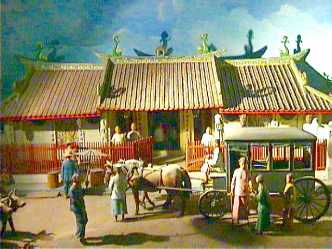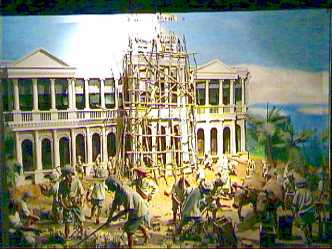|
|
 |
History | Independence
|
|
Singapore's merger with Malaysia lasted for only two years. when it was booted
out of the federation in 9th of August 1965, owing to the
disagreements on several fronts including racial issues. Singapore then became
a republic with Yusof bin Ishak as the first president. Singapore's strategy
was to take advantage of its strategic location and favorable world economy.
|
1963 - 1965 Merger Years
|

|
Our past differences with Malaysia in terms of political ideology, policy on racial equality and disagreement over the Common Market proposal culminated in the Separation from Malaysia in 1965. Singapore, however, held firm to the principles of meritocracy and multiracialism. The events, which preceded the Separation, like the racial riots in 1964, again demonstrated our vulnerabilities to exploitation of race and religious issues.
|
Merger Years
- Movie
Description
and Movie - Courtesy of Government of Singapore (Singapore
Infomap)
|
|
The Singapore Armed Forces Training Institute was established in 1966. The
following year, British Government decided to withdraw its armed forces at the
end of 1971. Singapore introduced compulsory National Service (NS) for the guys
to serve the army to protect the country. In August 1967, Singapore joined
Indonesia, Malaysia, Philippines and Thailand to form the Association of
Southeast Asian Nations (ASEAN).
In 1968, the one-party Parliament emerges from the general election. Massive
industrialization launched. Jurong Industrial Estate was extended and smaller
estates such as Kallang Park, Redhill and Tanglin Halt were created. The
Employment Act and the Industrial Relation Acts were also passed. Economic
Development Board was re-organized, Jurong Town Corporation (JTC) and the
Development Bank of Singapore (DBS) were set up.
By the year 1969, a Singapore Air Defense Command and a Singapore Maritime
Command were set up. The following year, Singapore evolved to a politically
stable state with a high rate of economic growth. The Monetary Authority of
Singapore was established to formulate and implement Singapore's monetary
policy. Public houses were given top priority and Singaporeans were allowed to
use their Central Provident Fund to pay for their apartments to encourage home
ownership.
At the end of 1971, the British withdrew their armed forces from Singapore and
Singapore set to build its own defense forces. For the next few elections, PAP,
won all seats except for the one in 1984 and 1991 when they lost 2 and 4 of the
seats in the general election respectively. The Government started a program of
economic restructuring. This was achieved by modifying education policies,
expanding technology and computer education, offering financial incentives to
industrial enterprises and launching a productivity campaign.
On 28th of November 1990, Mr Goh Chok Tong became the second Prime
Minister of Singapore when he took over the office from Lee Kuan Yew, who
resigned after being the Prime Minister since 1959.
|
From Survival to Progress
|
|
After the Separation, Singapore began her struggle for economic survival and defending her sovereignty, amidst challenges of boosting the people's morale and enhancing social cohesion. We built homes for our people, strengthened our defence and became a member of the United Nations and
ASEAN.
|

|
From Survival to Progress Movie
Description
and Movie - Courtesy of Government of Singapore (Singapore
Infomap)
|
|
Self
Government System
|
Into our Future
|
|
|
|
|